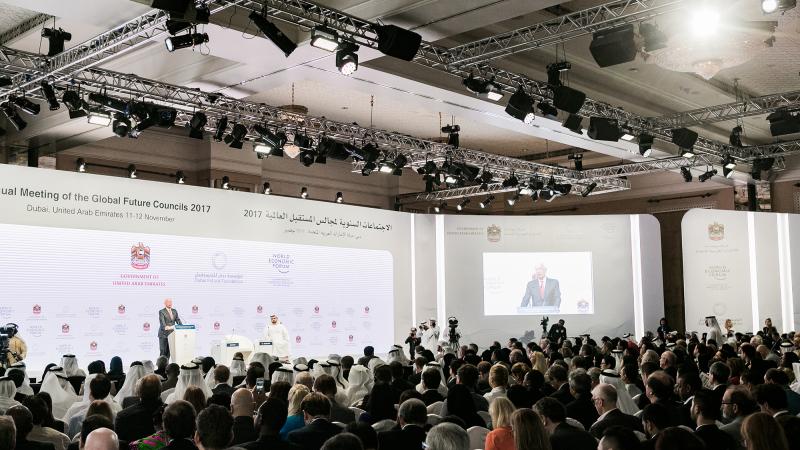President Shirley Ann Jackson co-chaired Global Future Council on the Future of International Security
November 14, 2017

Rensselaer Polytechnic Institute President Shirley Ann Jackson recently returned from the World Economic Forum’s Annual Meeting of the Global Future Councils, which took place Nov. 11-12 in Dubai. The annual meeting brought together more than 700 members of the Network of Global Future Councils to shape a better future.
The World Economic Forum’s Network of Global Future Councils is the world’s foremost interdisciplinary knowledge network dedicated to promoting innovative thinking on the future. The network convenes thought leaders from academia, government, business, and civil society to challenge conventional thinking and develop new insights and perspectives on the key global systems, as well as the impact and governance of key emerging technologies.
This year’s meeting was the second in the councils’ two-year term. It allowed members to jointly explore ways of facilitating systemic change in critical areas such as health, energy, and infrastructure through breakthrough technologies related to the Fourth Industrial Revolution.
“Scientific discovery and technological innovation are at the core of the solutions to many of the great challenges and opportunities of our time,” said President Jackson, co-chair of the Global Future Council on the Future of International Security. “Universities play a significant role in generating the ideas and sparking the innovations that drive the global economy and sustain our security. It is imperative that universities, business, and governments, along with NGOs, collaborate in charting a sustainable path forward. This gathering of world leaders offered an unparalleled opportunity to set the goals and enhance the interconnections that can help strengthen our institutions as we work to meet the challenges and tap the opportunities before us.”
The 2017 council focused on the future of the international security system and how to shape it. The following dimensions were highlighted:
* Strategic stability: What should be done to ensure technological capabilities are used in ways that maintain stability and promote a better level of international security as a global common good? What can be done to achieve better mutual understanding and transparency, reducing the risks of miscalculation? How can we avoid a future where technology favors the offensive, or emboldens aggression? What opportunities exist to use technology to solve familiar and new security challenges?
* A shift in the public/private balance: Much of the enabling technology for the Fourth Industrial Revolution is originated, developed, and exchanged in the private sector, where R&D budgets far exceed those of many industrialized countries. The scope for "dual purpose" technologies is increasing too. How will this affect issues like arms control regimes, proliferation, and the balance of power between state actors and non-state actors?
* New domains: Powerful, cheap, and freely available technology is lowering barriers to entry in new domains such as cyber, space, and the ocean depths. Where regimes of governance lag behind, this can tempt security actors to explore new operational courses of action, and prompt new arms races. What are the most pressing areas for action on governance, and what other approaches can be considered for preservation of global security?
Cynthia Collins, associate professor of chemical and biological engineering at Rensselaer, also participated in the meeting. Collins is a member of the Global Future Council on the Future of Biotechnology. “The Global Futures Councils provide a unique opportunity for experts from different sectors to step away from our silos and work together to develop and recommend innovative, cross-cutting solutions to global challenges. In discussions ranging from healthy living and precision medicine to modern industrial biotechnology, the need for multidisciplinary teams and system-level approaches to achieve the desired changes in these critical areas was a recurring theme.”
Participation in the World Economic Forum exemplifies the vision of The New Polytechnic, an emerging paradigm for higher education which recognizes that global challenges and opportunities are so great they cannot be adequately addressed by even the most talented person working alone. Rensselaer serves as a crossroads for collaboration—working with partners across disciplines, sectors, and geographic regions—to address complex global challenges, using the most advanced tools and technologies, many of which are developed at Rensselaer. Research at Rensselaer addresses some of the world’s most pressing technological challenges—from energy security and sustainable development to biotechnology and human health.
About Rensselaer Polytechnic Institute
Rensselaer Polytechnic Institute, founded in 1824, is America’s first technological research university. For nearly 200 years, Rensselaer has been defining the scientific and technological advances of our world. Rensselaer faculty and alumni represent 85 members of the National Academy of Engineering, 17 members of the National Academy of Sciences, 25 members of the American Academy of Arts and Sciences, 8 members of the National Academy of Medicine, 8 members of the National Academy of Inventors, and 5 members of the National Inventors Hall of Fame, as well as 6 National Medal of Technology winners, 5 National Medal of Science winners, and a Nobel Prize winner in Physics. With 7,000 students and nearly 100,000 living alumni, Rensselaer is addressing the global challenges facing the 21st century—to change lives, to advance society, and to change the world. To learn more, go to www.rpi.edu.
Contact
newsmedia@rpi.edu
Visit the Rensselaer research and discovery blog: http://approach.rpi.edu
Follow us on Twitter: www.twitter.com/RPInews